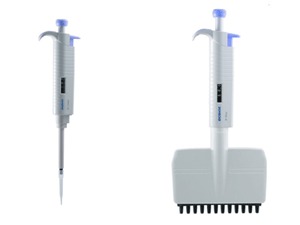PIPETTE AND MICROPIPETTE CALIBRATION SERVICE
1. Purpose:
Determining the actual volume of pipettes and micropipettes contributes to ensuring the accuracy of quantitative results.
2. Scope of Application:
Applicable for calibrating various types of pipettes and micropipettes in the Quality Control Laboratory.
3. Personnel Responsible:
Employees assigned to calibration.
4. Procedure:
4.1. Pipette Calibration
a. Equipment and Instruments:
- Glass thermometer.
- Deionized CO2-free water.
- 4-decimal analytical balance.
- Graduated flask with lid.
- Clean calibrated pipette (check cleanliness as with burettes).
b. Implementation:
- Weigh a clean, dry flask with a stopper (accurate to 0.1mg). Ensure not to touch the flask with hands to obtain mass m1.
- Use the pipette to draw a volume of deionized CO2-free water up to the specified mark. Record the temperature of the water (t).
- Transfer the water from the pipette to the flask. Close the stopper and weigh accurately to 0.1mg to obtain mass m2.
- Refer to the table to find the correction factor for the water temperature (Ft – as in the calibrated flask calibration section).
Calculate using the following formula:
Actual volume V (ml) = (m2 – m1) x Ft
Example: 10 ml pipette
m2 = 31.9961g
m1 = 22.0391g
t = 24°C
Ft = 1.003771 (approximately 1.0038 from the table)
Actual volume = (31.9961 – 22.0391) x 1.003771 = 9.9945 ml
Deviation from theoretical volume:
Deviation = (10 – 9.9945) x 100/10 = 0.055%
Typically, deviation (≤ 0.1%) is acceptable.
4.2. Micropipette Calibration
a. Equipment and Instruments:
- All glassware must be Type A.
- Reagents:
- NaOH 0.01 mol/L solution
- P-nitrophenol solution 105 mg/quantification
b. Implementation:
- Dissolve 105 mg of pure p-nitrophenol NIST SRM in deionized water and make up to 100 ml in a standard graduated flask.
- Prepare reference solution and test solution.
- Reference solution: Prepare 3 standard graduated flasks containing 250 ml of NaOH 0.01 mol/L, add 1 ml of p-nitrophenol solution using 3 separate calibrated pipettes (Each pipette per flask).
- Test solution: Prepare 5 test tubes containing 2.5 ml of NaOH 0.01 mol/L, add 10 μl of p-nitrophenol solution using the micropipette to be calibrated. If the pipette is of the to-deliver (TD) type, coat it with p-nitrophenol.
- Measure the absorbance of the reference solution and test solution on a narrow spectrum UV-Vis spectrophotometer using a 10 mm quartz cuvette, wavelength 401 nm.
- For p-nitrophenol NIST SRM 131.48 L/g/cm-1 in NaOH 0.01 mol/L, A401 = 0.550.
- The average absorbance of 3 reference solutions A1 should be approximately 0.550.
- The average absorbance of 5 test solutions is A2.
- Calculation:
Actual volume (μl) = A2 x D x V / A1
Where:
D = dilution factor of the test solution (1/251 = 250 ml alcohol + 1 ml p-nitrophenol)
V = volume (μl) of the test solution (2510 = 2.5 ml NaOH + 10 μl p-nitrophenol)
If A1 = 0.550 A2 = 0.561
Actual volume = (0.561/0.550) x (1/250) x 2510 = 10.2 μl
Error = (10.2 - 10) x 100/10 = 2%
Typically, errors from 0.5% to 1.0% are acceptable.
Contact 3D Vina immediately via our Email or Hotline: (+84) 902145345 for advice!





